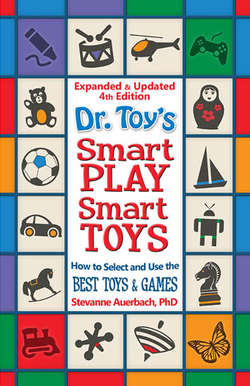Читать книгу Dr. Toy's Smart PLAY Smart Toys – Expanded & Updated 4th Edition - Stevanne Auerbach - Страница 8
На сайте Литреса книга снята с продажи.
ОглавлениеCOMMENTS on PLAY & TOYS
Play is not automatic. It is learned. The importance of play for children has been well researched and demonstrated. For example, did you ever consider that play is one of the most important areas of activity in which children engage as they grow and develop? Did you know that play has been shown to contribute positively to a child’s later academic learning? Did you know that play is one of the most important factors in a child’s learning how to interact with other children? Did you know that language development could be enhanced through children’s play? Did you know that the abstract thinking, developed through play, forms a critical basis for a child’s later learning in school, as well as exerting a strong influence into adult life? Have you, as an adult, ever participated in imaging exercises? Did you know that there is a direct relationship between your own childhood play and your ability to image creatively and imaginatively project what should happen within your work organization or within your own family? These linkages become increasingly clear as you use this fine reference book. An entire volume devoted to the many nuances of children’s development as seen from the perspective of children’s play is both timely and very welcome. Throughout her book, Dr. Auerbach describes through many helpful examples, ways to develop and enhance a child’s “Play Quotient.”
— EDGAR KLUGMAN, PHD
Professor, Early Education, Wheelock College
Much more is being learned about play than we would have expected a decade ago. A new period of research on play is underway. The new work begins to suggest why play is the principal business of childhood, the vehicle of improvisation and combination, the first carrier of rule systems through which a world of cultural restraint is substituted for the operation of impulse. If the rule structure of human play and games sensitizes the child to the rules of culture, both generally and in preparation for a particular way of life, then surely play must have some special role in nurturing symbolic activity generally.
— JEROME BRUNER, PHD
Child’s Play
All children learn through active participation, by being involved in a practical way, and by attempting to do something themselves, particularly by using their hands. Montessori put great emphasis on this connection between the brain and movement: Watching the child makes it obvious that the development of his mind comes about through his movements, she felt. She believed the process of learning had three parts: the brain, the senses, and the muscles, and that all three must cooperate for learning to take place. To start with, they learn through play, through experimenting with things in the world around them—for example, the idea that water is wet, that it can be hot or cold, that it can be poured from one container into another, as well as lots of other things, will be learned by your baby or child through playing with water in the bathroom or the kitchen in the normal course of his life. This spontaneous play is initiated in response to his developmental needs. What you can do to help him is to arrange your home so that it can make available as many different experiences and activities as possible, which are appropriate for his age. It is also important that you join in these activities yourself, providing encouragement and social interaction, and also be there to keep an eye on any problem situations that might arise.
— LESLEY BRITTON
Montessori Play & Learn
Play must be considered a powerhouse of learning. Play needs to be given its due recognition. It must be measured eventually by insightful tests as yet not developed. Until the true learning power in play in early childhood is thoroughly and accurately researched, parents, teachers, and psychologists need to maintain their intuitive belief in the tremendous learning power inherent in child play.
— FRANK AND THERESA CAPLAN
The Power of Play
Toys are the tools of self-assertion. Obviously, it is not always easy to tell when a child is exploring or is testing itself with a toy, but it is more likely to be revealed in highly repetitive acts with familiar toys than with the cautious examination of novel ones. Though we might call this activity self-testing behavior, the more frequent usage of the word “mastery” in the literature would seem to suggest its value. Toys echo these other patterns, and yet, as vehicles of intelligence and of play, they also have their own impact in myriad ways, all of which are much more deserving of our social scientific concern than has hitherto been the case.
— BRIAN SUTTON SMITH, PHD
Toys As Culture
